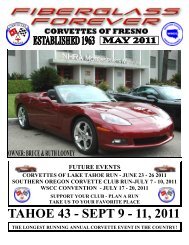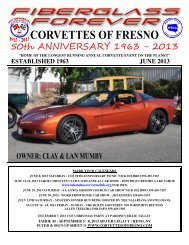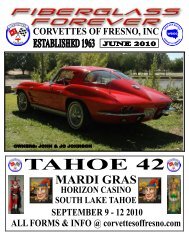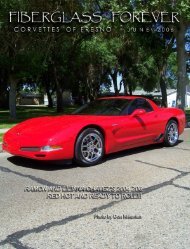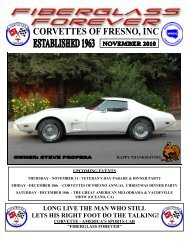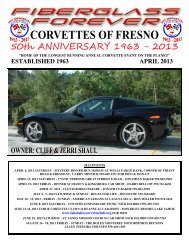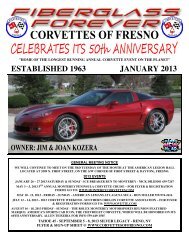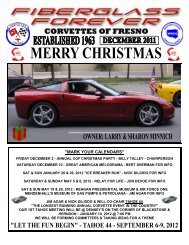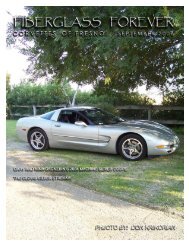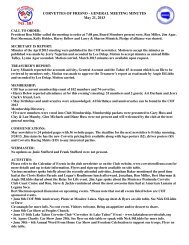corvettes of fresno - Description: Description: Description ...
corvettes of fresno - Description: Description: Description ...
corvettes of fresno - Description: Description: Description ...
Create successful ePaper yourself
Turn your PDF publications into a flip-book with our unique Google optimized e-Paper software.
Velocity Raptor<br />
Each year, Continental Tires invites Europe’s top car tuners to southern Italy for its Nardo High<br />
Performance Event. The competition is simple: The team that sets the highest top speed wins.<br />
Modified Porsches have dominated the event, with other German brands usually filling up the rest <strong>of</strong><br />
the leader board. This year, however, an American car is vying for overall honors—a Chevrolet<br />
Corvette Z06.<br />
Munich, Germany’s Geiger Cars has been specializing in American vehicles since 1979. Though<br />
it imports new and used cars and sells many <strong>of</strong> them as-is, Geiger is best known for its modified<br />
machines—and it pulled out all the stops with the Corvette it brought to Nardo. The factory “Z06 505<br />
HP” badges on its flanks no longer tell the truth: They are pessimistic to the tune <strong>of</strong> 385 horsepower.<br />
While the Geiger Z06 Bi-Turbo’s claimed 890 bhp is bested by the 1,000 ponies <strong>of</strong> the 9ff-modified<br />
Porsche 911 Turbo, the Corvette, with its lurid Kermit-green paint scheme, is definitely the most eyecatching<br />
machine present. Will it be the fastest?<br />
Speaking to one <strong>of</strong> the Geiger mechanics, we learn that the Bi-Turbo did not start <strong>of</strong>f as an<br />
<strong>of</strong>ficial part <strong>of</strong> the Bavarian company’s Corvette tuning program. Instead, like the ZR1, it was<br />
envisioned and built by a couple <strong>of</strong> engineers in their spare time. When the conversion was finished,<br />
company boss Karl Geiger was so impressed with the car’s ballistic performance, he sanctioned its<br />
use for publicity work, including this Nardo shoot-out.<br />
Not surprisingly, the biggest changes to the car were made in the engine compartment. The stock<br />
Z06’s hand-built 7,001-cc LS7 V8 is already a heavily tuned version <strong>of</strong> the standard V8, with forged<br />
titanium connecting rods, titanium inlet valves and sodium-cooled exhaust valves. These racy<br />
components allow this big engine to rev to 7,000 rpm, yet the V8 produces a reliable 505 bhp all day<br />
long.<br />
When the factory came up with the idea <strong>of</strong> using a supercharger on the Corvette ZR1, it decided<br />
that the LS7 block was not man enough for the job, and used the 6,162-cc LS3 as starting point<br />
instead. This variant <strong>of</strong> the legendary small-block V8 has thicker cylinder walls to better withstand the<br />
higher combustion pressures <strong>of</strong> forced aspiration.<br />
The Geiger engineers, on the other hand, were not only confident the LS7’s cylinder walls could<br />
handle a blower, they felt they could be even thinner, and proceeded to bore out the V8 to a<br />
monstrous 7.6 liters. In the process, they fitted lightweight forged pistons, titanium valve springs and a<br />
more aggressive camshaft. Only then did they strap a pair <strong>of</strong> turbochargers to custom-made exhaust<br />
manifolds and fit a substantial intercooler down low in the nose.<br />
This heavy-breathing engine required a high-flow air intake system with a big 100-mm throttle<br />
body and a new fuel-injection system with larger pumps. Spent gases exit via a large-diameter<br />
exhaust system with special low-restriction catalytic converters. The final step for the engineers was<br />
to remap the engine computer to suit the new fuel and spark parameters. The result <strong>of</strong> all their afterhours<br />
hard work was 890 bhp at 6,100 rpm and 694 lbs-ft <strong>of</strong> torque at 4,500 rpm.<br />
This huge increase in output necessitated a number <strong>of</strong> other mods. First <strong>of</strong> all, the extreme heat<br />
generated by the turbos required that a heavily vented hood be fitted. The redesigned nose clip, with<br />
its larger central opening and additional side intakes, directs cooling air to the intercooler and front<br />
brakes. The rear end also incorporates unique Geiger fiberglass bodywork, including a rounded tail<br />
piece with an integrated spoiler and a diffuser panel. In conjunction with the aggressive front splitter,<br />
they are said to reduce aerodynamic lift without increasing drag. The only original bodywork pieces<br />
left on the Z06 Bi-Turbo are the doors and rear-quarter panels.<br />
The Geiger crew next dismantled the Z06’s six-speed manual gearbox and rebuilt it using<br />
reinforced components. They then fitted a race-grade dual-disc clutch, a carbon-fiber propshaft and a<br />
stronger rear differential and halfshafts.<br />
To prepare the chassis for high-speed runs, the engineers swapped the stock suspension for<br />
Geiger’s fully adjustable coil-over kit, which uses a combination <strong>of</strong> H&R springs and KW dampers<br />
with adjustable spring platforms. The ride height is set 25 mm lower than stock, an important mod




